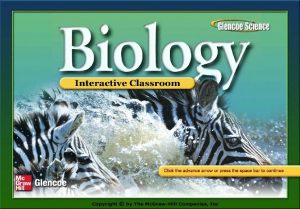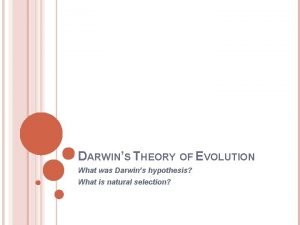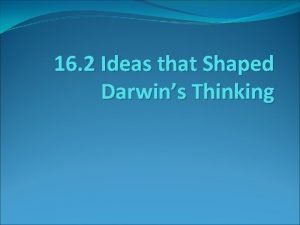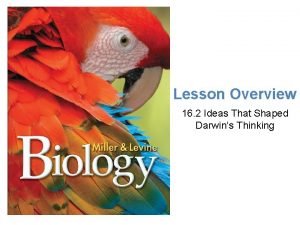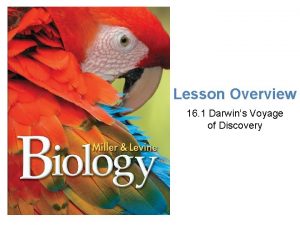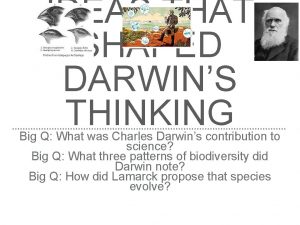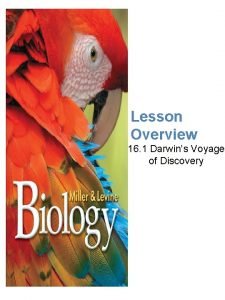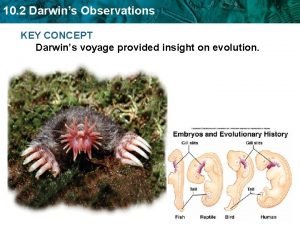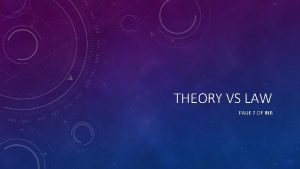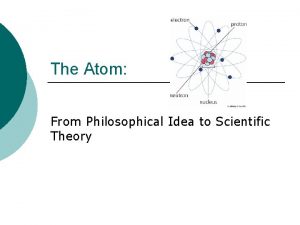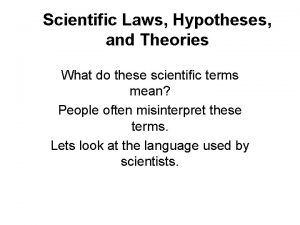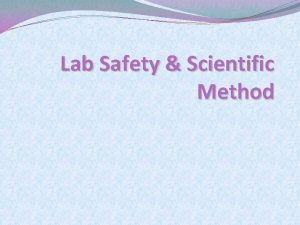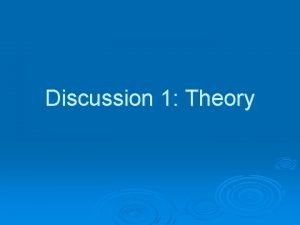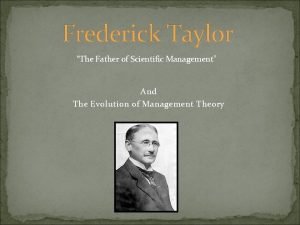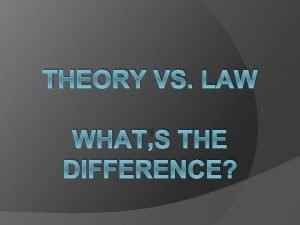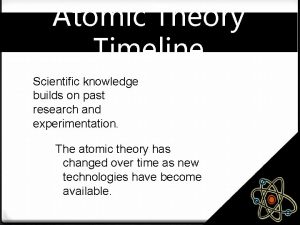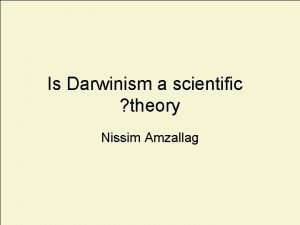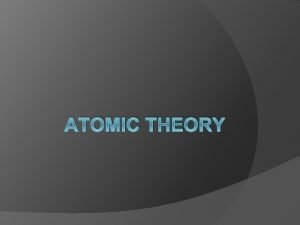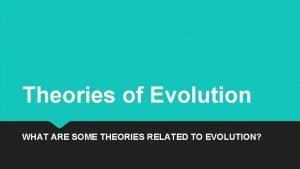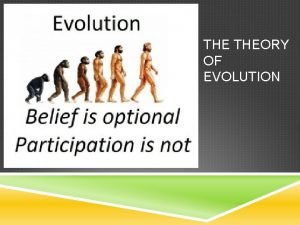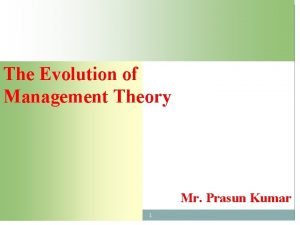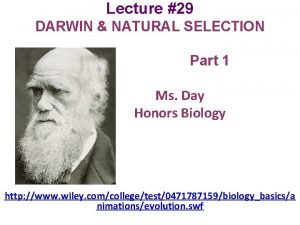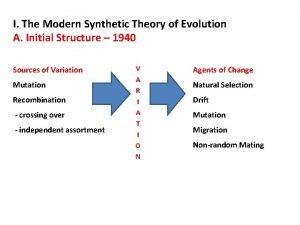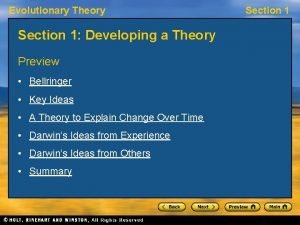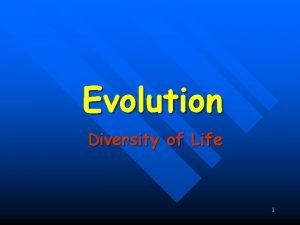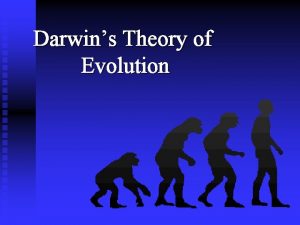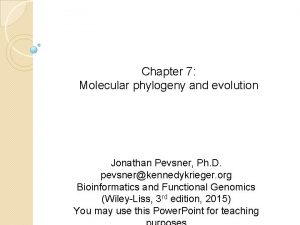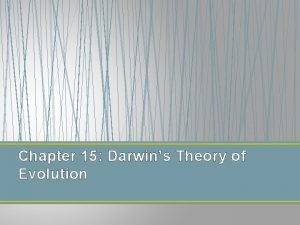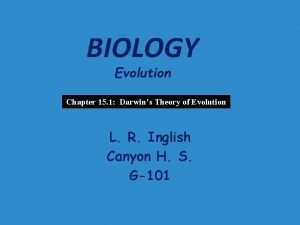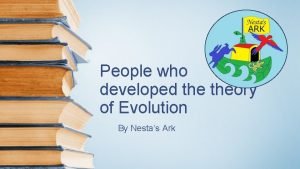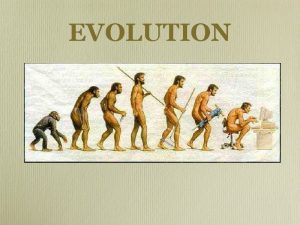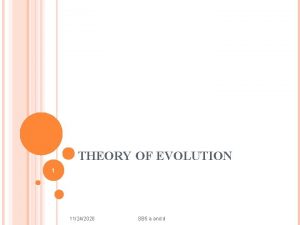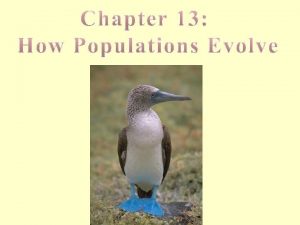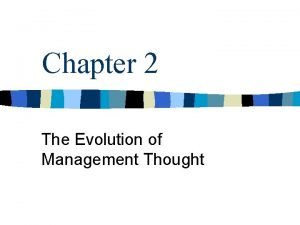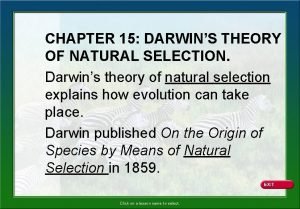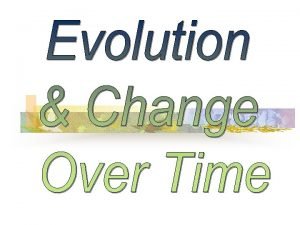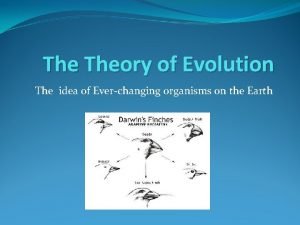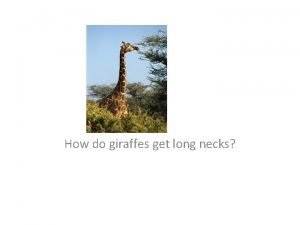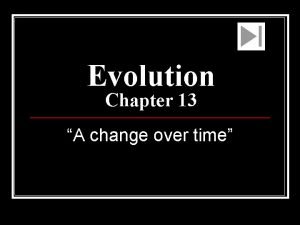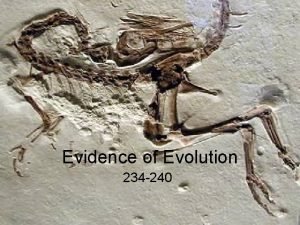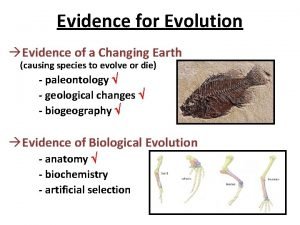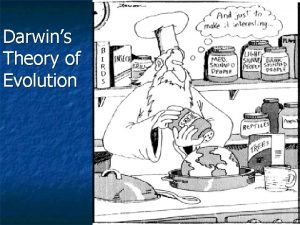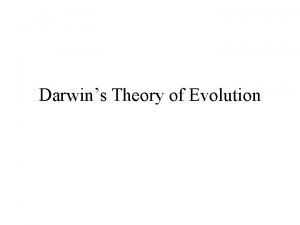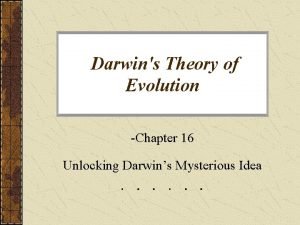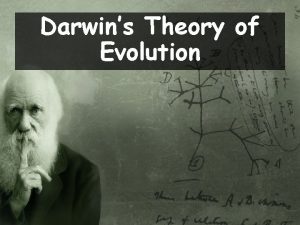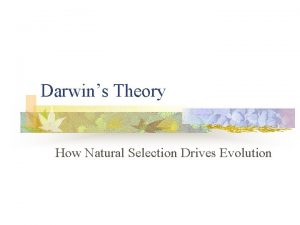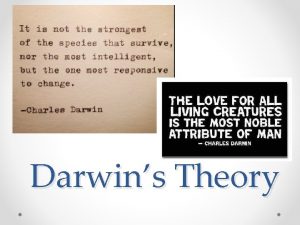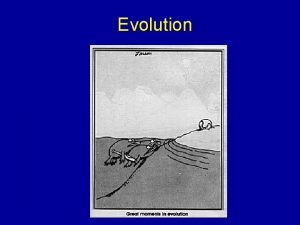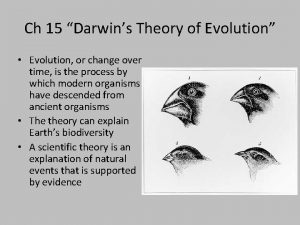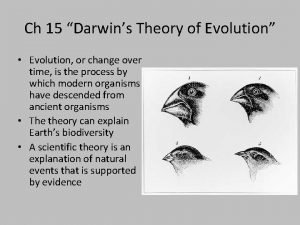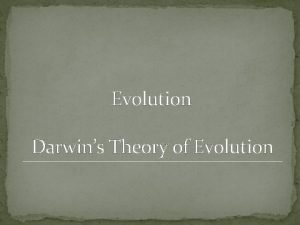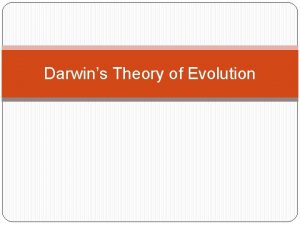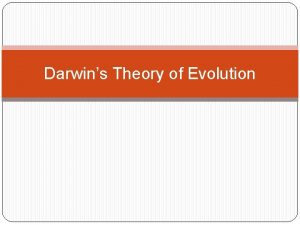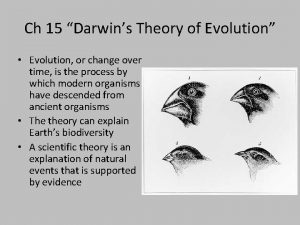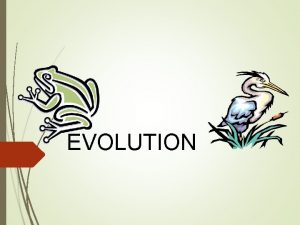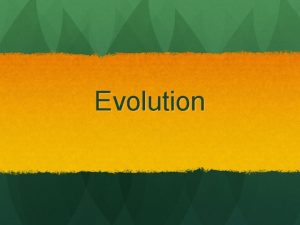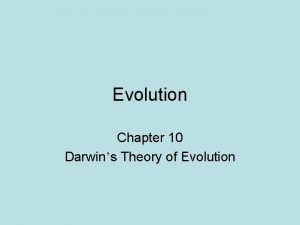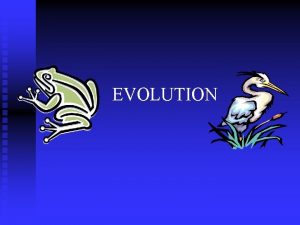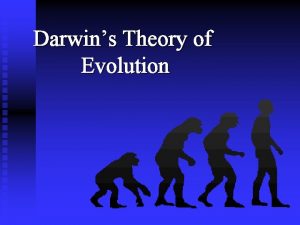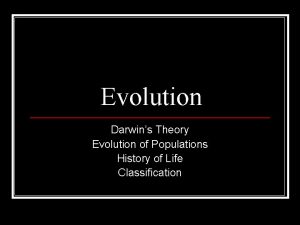Darwins Theory of Evolution Evolution A scientific theory


















































- Slides: 50

Darwin’s Theory of Evolution

Evolution • A scientific theory is NOT just a belief, it is a well-supported tested explanation. • Evolution means change over time Darwin • In 1831 Darwin sets sail on the HMS Beagle. • In 1844 he writes his theory on the origin of species. • In 1858, Darwin and Wallace publish their theories on evolution.

History of Darwin’s Studies • Darwin went on an aroundthe-world trip on the HMS • Beagle and traveled to the Galapagos Islands. • He particularly liked and observed the finches. He also observed the tortoises on different islands. • He observed each different group had its own niche. He studied 13 different species and saw how they adapted to their environment.


An Ancient, Changing Earth • In 1785 James Hutton • Charles Lyell agreed proposed the Earth is and wrote a book in shaped by geological 1833 the explained the forces that took place shaping of Earth’s over extremely long geological features. periods of time. He • He gave his book to estimated the earth is Darwin before Darwin millions, not thousands set sail. of years old.

Population Growth • In 1798 Malthus reasoned that if the human population continued to grow unchecked, sooner or later there would be insufficient living space and food for everyone. Population Control • Darwin read Malthus’ work reasoned that there is always competition for food, water and space in the environment. The individuals that survive the competition can then reproduce.

Lamark • In 1809 Jean-Baptiste • Lamarke hypothesized that “simple” organisms emerge spontaneously and evolve to greater “complexity”. • Lamark’s hypothesis about acquired characteristics was disproved by Weisman, who concluded that changes in an individual during a lifetime do not affect its offspring. 3 principles to his theory: 1. Organisms constantly strive to improve themselves. 2. Most used body structures develop and unused waste away. 3. A structure is modified by use or disuse, the modification is inherited to the offspring. (Inheritance of acquired characteristics. )

Darwin’s Arguments • Darwin argued that only biologically inherited characteristics were advantageous in surviving and reproducing. The offspring would also inherit and pass on those advantages, and over generations the aggregation of these inherited advantages would lead to new species.

Returning Home . • He also studied the selective breeding of domestic animals and crops. • He found that any domesticated plant or animal bred to accentuate desirable characteristics is the result of artificial selection. (Natural provides variation and humans select the variations useful) • Many veggies we eat today came from the wild mustard plant through artificial selection.

Origin of Species • Darwin’s book, published in 1859, was a quick success. It came from the clear and understandable argument that natural selection and selective breeding of animals was in wide use at the time. There was a massive array of biological and fossil evidence to support the argument. 2. 3

Variation • A species consists of interbreeding populations organisms that produce healthy offspring. • Within a species there is much variation or differences between members of a population. • Variation can be dramatic or subtle. • Examples of how organisms may vary: – – – Fur color Shape of teeth Size Markings Eye color

Other things that cause Variation Inherited variation: 1. Mutation 2. Recombination • Most mutations are either neutral or harmful, sometimes they may increase the chance for survival, esp. when the environment is changing. • Ie. Silver colored fox in a snowy environment.

Biodiversity • In communities populations of organisms live to • There are between 5 together, interact, and often and 30 million compete for natural different species. resources. These • 99% of all organisms communities include a that ever lived are now collection of niches. The extinct. variety and abundance of species that make up a biological community is called biodiversity.

Biodiversity is Good • The great diversity of species increases the chance that at least some living things will survive in the face of the large changes in the environment. • Genetic recombination allows for a greater diversity.

Niches • Through adaptation, populations often become suited to a specific niche. • Niche- habitat and the role of a population plays in that habitat. • It includes: – Where organisms live – What and how they eat – How they raise their offspring – What their predators are – Space – Light – Moisture – Temperature

Adaptation • An adaptation is an • The ability of an inherited trait that individual to survive increases a and reproduce in its population’s chance of specific environment survival and is fitness. reproduction in a particular environment.

Survival of the Fittest • Individuals that are best suited to an environment (adaptations that enable fitness) survive and reproduce most successfully. • Over time, natural selection results in changes in the inherited characteristics of a population. These changes increase a species fitness in its environment.

Natural Selection • 4 Main Points. 1. 2. 3. 4. 5. There is variation with a population. Some variations are favorable. Not all young produced in each generation survive. Individuals that survive and reproduce are those with favorable variations. Descent with Modification

Natural Selection • Natural Selection leads to organisms that are well suited in particular environments. • It provides a scientific explanation for the history of life on Earth as depicted in the fossil record and similarities evident within the diversity of existing organisms. 1. 32

Descent with Modification • Over time, natural selection produces organisms that have different structure, establish different niches, or occupy different habitats. As a result, they look different from their ancestors. • Common descent- all living and extinct organisms were derived from a common ancestor.

Structures • Homologous Structures- • Vestigial Structures- inherited, traits that are similar in but reduced in size and often different species because unused. the species share a Ie. Pythons have hip and leg common ancestor. bones. Ie. Arm, fin and wing may have evolved from Analogous structures- those that the forelimb of a common are similar in function, but are not inherited from a common vertebrate. ancestor. Ie. Insect and Bird Wings

Evidence of Evolution • Darwin argued that living things have been evolving on Earth for millions of years. • 1. Fossil Record- layers of earth • 2 Geographical distribution of living species- similar animals in different locations were the product of different lines of evolutionary descent. • 3. Homologous structures • 4. Similarities in early development (embryology)

Evolution of Populations

Population Genetics In genetic terms, evolution is any change in the allele frequency (relative frequency) of alleles in a population • Gene pool- all the combined genetic material of all of the members of a given population. • Allele frequency- the • Sexual reproduction can number of each allele is a produce many different fraction of all of the genes phenotypes, but it does not change the relative for a particular trait. (pg. frequency of alleles in a 394) population. Think of deck of cards. 1. 36


Single Gene and Polygenic Traits • Single gene trait is controlled by one gene – – – Widows peak Freckles Dimples Roll tongue Taste PTC • Polygenic traits are controlled by many genes. – Body stature – Eye color – Height

Natural Selection on Polygenic Traits • Natural selection can affect the distributions of phenotypes in 3 ways. 1. Directional selection 2. Disruptive selection 3. Stabilizing selection Microevolution: a change in the allele frequency of a species or population

Directional and Disruptive Selection • Directional Selection occurs when a change in the environment favors an extreme phenotype. • What is a phenotype and what are some examples? • Ie. Peppered moth • Disruptive selection occurs when an environmental change makes it unfavorable to have a medium phenotype. You need an extreme one.

directional disruptive stabilizing

Testing Natural Selection in Nature • Rosemary and Peter Grant visited the Galapagos Islands and did not see the different finches competing or eating different foods. During the rainy season, there is plenty of food and finches are able to eat anything. In the dry season drought, food becomes scarce and differences in beak size can mean the difference between life and death. What time of selection is this? • Directional Finches video

Directional Selection Example Directional selection favors those individuals who have extreme variations in traits within a population. A useful example can be found in the breeding of the greyhound dog. Early breeders were interested in dog with the greatest speed. They carefully selected from a group of hounds those who ran the fastest. From their offspring, the greyhound breeders again selected those dogs who ran the fastest. By continuing this selection for those dogs who ran faster than most of the hound dog population, they gradually produced a dog who could run up to 64 km/h (40 mph). The greyhound was originally used to hunt the fastest of game, fox and deer. Their bred dates to Egypt in 3 BC.

Hardy Weinberg Principle • If a population is not evolving, the allele frequencies in the population remain stable. • This constant state of allele frequency is called genetic equilibrium. • It states that, under specific conditions, allele frequencies in a population remain constant from generation to generation. If specific conditions are not met, genetic equilibrium in interrupted and the population may evolve.

Maintaining Genetic Equilibrium • 5 conditions: 1. No natural selection 2. Random mating 3. No migration 4. No significant mutations. 5. Very large population

The Hardy-Weinberg equation is used to predict genotype frequencies in a population. • Predicted genotype frequencies are compared with actual frequencies. – used for traits in simple dominant-recessive systems – must know frequency of recessive homozygotes – p 2 + 2 pq + q 2 = 1 "The Hardy-Weinberg equation is based on Mendelian genetics. It is derived from a simple Punnett square in which p is the frequency of the dominant allele and q is the frequency of the recessive allele. "

Genetic Drift • Genetic Drift is the random change in allele frequencies in a population due to chance events, such as natural disasters or migration. (Would genetic drift have a greater impact on smaller or larger populations? ) • “Bottlenecking” is when genetic drift occurs after a random population reducing event. • The more variation, the easier it is to survive because they can adapt better.

An example is the Cheetah.

Founder effect • Allele freq. change as a result of the migration of a small subgroup of population. • Will the new population become different or more like the parent population? • Due to chance • Ex: Hawaiian Fruit Flies Genetic Drift Video

Speciation • Speciation is the evolution of one or more species from a single ancestor species. • It can occur when members of a population become isolated from each other. (possibly from earthquakes. ) • Once two populations are reproductively isolated, they are considered separate species.


Allopatric Speciation • Aka. Geographical Isolation • Physical barrier ( continental split, rise in sea level, formation of mountain range, advance of glacier, change in habitiat) prevents gene flow between populations of a species – Archipelago hotbed of speciation

Allopatric Speciation in the Grand Canyon

Behavioral Isolation • Two populations are capable of interbreeding, but have differences in courtship rituals or other reproductive strategies.

Temporal Isolation • Two or more species reproduce at different times. • Orchid releasing pollens on different days, they can’t pollinate each other.

Speciation in Darwin’s Finches • Speciation in the Galapagos finches occurred by: • 1. Founding of a new population. • Geographic isolation • Changes in new population’s gene pool • Reproductive isolation • Ecological competition

Evolution does not occur in a set direction • Evolution builds on what already exists, so the more variety there is, the more there can be in the future. • However, evolution does not necessitate long-term progress in a set direction.

Rate of Evolution • Gradualism- theory that • Punctuated equilibriumnew species evolve as theory that populations genomes of two remain genetically stable for populations differentiate long period of time, over enormous spans of interrupted by brief periods time. of repaid genetic change. (Small genetic changes • Rapid genetic changes in a occur slowly within a population can result in the population. ) evolution of new species.

Graduated vs. Punctual

Mechanisms of Evolution • Divergent Evolution • Convergent Evolutionwhen isolated populations occurs when natural of a species evolve selection has produced independently. It occurs analogous adaptations in when geographic barriers response to similar separate population environment between members or when a small different species. group leaves an original Ie. Maned Wolf and population. Serval Cat • Ex: polar bears and brown Eat same, legs same, bears same.

Coevolution • Species that interact closely often adapt to one another in a process called coevolution. • What does the prefix co- mean? • Ex: – Predatory birds and mimicry of butterflies – Parasites and hosts – Plant-eating animals and the plants they eat – Plants and the animals that pollinate them.

Adaptive Radiation is the evolution of many diversely adapted species from one common ancestor. It usually occurs on an isolated island. ie. Finches that Darwin studied all came from common ancestor, but had different beaks for the kind of food they ate.
 Chapter 17 darwins theory of evolution
Chapter 17 darwins theory of evolution Chapter 15 section 1 darwins theory of natural selection
Chapter 15 section 1 darwins theory of natural selection Darwin hypothesis
Darwin hypothesis How is a scientific law different from a scientific theory?
How is a scientific law different from a scientific theory? Section 15-2 ideas that shaped darwins thinking
Section 15-2 ideas that shaped darwins thinking 15-2 ideas that shaped darwin's thinking
15-2 ideas that shaped darwin's thinking Adaptation
Adaptation Lesson 2: ideas that shaped darwin's thinking
Lesson 2: ideas that shaped darwin's thinking Species vary locally
Species vary locally Ideas that shaped darwins thinking
Ideas that shaped darwins thinking Lesson 1 darwins voyage of discovery
Lesson 1 darwins voyage of discovery Darwins observations
Darwins observations Information gathered during an experiment
Information gathered during an experiment Scientific theory vs law
Scientific theory vs law The atom from philosophical idea to scientific theory
The atom from philosophical idea to scientific theory Scientific law vs theory
Scientific law vs theory Scientific theory vs law
Scientific theory vs law Cognitive dissonance marketing
Cognitive dissonance marketing Who is the father of scientific management?
Who is the father of scientific management? Difference between theory and law
Difference between theory and law Ernest rutherford atomic model
Ernest rutherford atomic model Scientific theory
Scientific theory The atom from philosophical idea to scientific theory
The atom from philosophical idea to scientific theory Lamarck's theory of evolution
Lamarck's theory of evolution Developmental homologies
Developmental homologies Evolution of management theory
Evolution of management theory Lamarck's theory
Lamarck's theory Synthetic theory
Synthetic theory Modern evolution theory
Modern evolution theory Lamarck’s theory of evolution.
Lamarck’s theory of evolution. What was lamarck's theory of evolution
What was lamarck's theory of evolution Chapter 15 darwin's theory of evolution
Chapter 15 darwin's theory of evolution Neutral theory of molecular evolution notes
Neutral theory of molecular evolution notes Chapter 15 section 3: shaping evolutionary theory
Chapter 15 section 3: shaping evolutionary theory Chapter 15 darwin's theory of evolution section 15-1
Chapter 15 darwin's theory of evolution section 15-1 Chapter 15 darwin's theory of evolution section 15-1
Chapter 15 darwin's theory of evolution section 15-1 Explain the theory of evolution
Explain the theory of evolution Theory of natural selection
Theory of natural selection Lamarck theory of evolution notes
Lamarck theory of evolution notes Theory of evolution
Theory of evolution Theory of evolution
Theory of evolution Chapter 2 the evolution of management thought pdf
Chapter 2 the evolution of management thought pdf Natural selection
Natural selection What does darwin's theory of evolution suggest?
What does darwin's theory of evolution suggest? Law of natural selection
Law of natural selection Lamarck theory of evolution notes
Lamarck theory of evolution notes Darwin's theory of evolution
Darwin's theory of evolution Convergent evolution
Convergent evolution The theory that evolution occurs slowly but steadily
The theory that evolution occurs slowly but steadily Evidence for evolution
Evidence for evolution The theory that evolution occurs slowly but steadily
The theory that evolution occurs slowly but steadily

